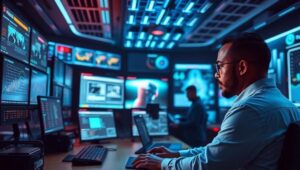AI and Automation: Augmenting, Not Replacing, Cyber Pros (2026)
The cybersecurity landscape is in constant flux, with threats becoming more sophisticated and frequent. As we move towards 2026, Artificial Intelligence (AI) and automation are increasingly touted as potential solutions to bolster our defenses. However, a common misconception is that these technologies will replace cybersecurity professionals. This article explores why AI and automation should be viewed as tools that augment human capabilities rather than outright replacements.
The Current State of Cybersecurity
Before delving into the role of AI and automation, it’s crucial to understand the current challenges faced by cybersecurity teams:
- Talent Shortage: The cybersecurity industry is grappling with a significant shortage of skilled professionals. This gap leaves organizations vulnerable to attacks.
- Alert Fatigue: Security Operation Centers (SOCs) are often overwhelmed with alerts, many of which are false positives. This leads to burnout and missed critical incidents.
- Evolving Threats: Attackers are constantly developing new techniques, making it difficult for human analysts to keep up.
- Data Overload: The sheer volume of data generated by security systems can be overwhelming, making it difficult to identify meaningful patterns and anomalies.
How AI and Automation Augment Cyber Pros
AI and automation offer powerful capabilities that can address these challenges and enhance the effectiveness of cybersecurity teams:
- Threat Detection: AI algorithms can analyze vast amounts of data to identify suspicious activities and potential threats in real-time. This helps reduce the burden on human analysts and improves detection accuracy.
- Automated Response: Automation can be used to automatically respond to certain types of threats, such as isolating infected systems or blocking malicious traffic. This frees up human analysts to focus on more complex incidents.
- Vulnerability Management: AI can assist in identifying and prioritizing vulnerabilities in systems and applications. This allows organizations to proactively address weaknesses before they can be exploited.
- Security Orchestration: Automation platforms can orchestrate different security tools and processes, streamlining workflows and improving incident response times.
- Enhanced Analysis: AI can augment human analysis by providing insights and context that would be difficult or impossible to obtain manually.
The Human Element Remains Essential
While AI and automation offer significant benefits, they are not a silver bullet. Human expertise remains crucial for several reasons:
- Complex Investigations: Many security incidents require human intuition and judgment to fully understand and resolve. AI can assist in these investigations, but it cannot replace human analysts.
- Strategic Thinking: Developing and implementing cybersecurity strategies requires human insight and experience. AI can provide data and analysis, but it cannot make strategic decisions.
- Ethical Considerations: The use of AI in cybersecurity raises ethical concerns that must be addressed by humans. For example, AI-powered threat detection systems may disproportionately target certain groups or individuals.
- Adaptability: Human analysts are able to adapt to new threats and situations more quickly than AI systems. This is particularly important in the face of evolving attack techniques.
- Creative Problem-Solving: Cyber attackers often employ creative and unconventional methods. Human analysts are better equipped to think outside the box and develop innovative solutions.
Looking Ahead to 2026
In 2026, we can expect to see even greater integration of AI and automation in cybersecurity. These technologies will become increasingly sophisticated and capable, augmenting the abilities of cyber professionals in new and innovative ways. However, it is important to remember that AI and automation are tools, not replacements. The human element will remain essential for effective cybersecurity.
Key Takeaways:
- AI and automation are valuable tools for enhancing cybersecurity defenses.
- These technologies augment human capabilities rather than replacing them.
- Human expertise remains crucial for complex investigations, strategic thinking, and ethical considerations.
- The cybersecurity landscape of 2026 will be characterized by greater integration of AI and automation, with human professionals playing a vital role.




